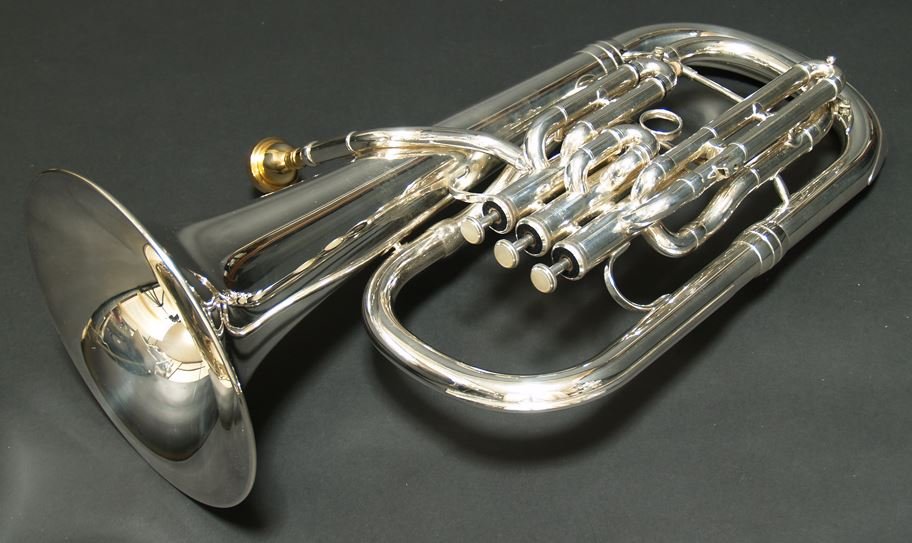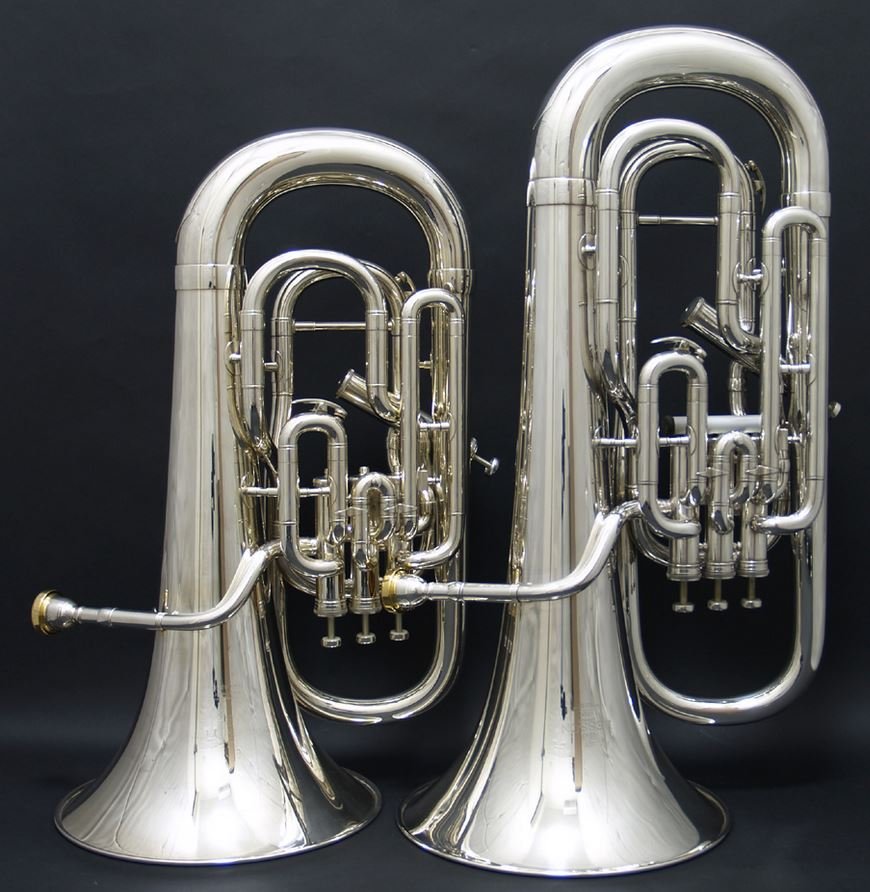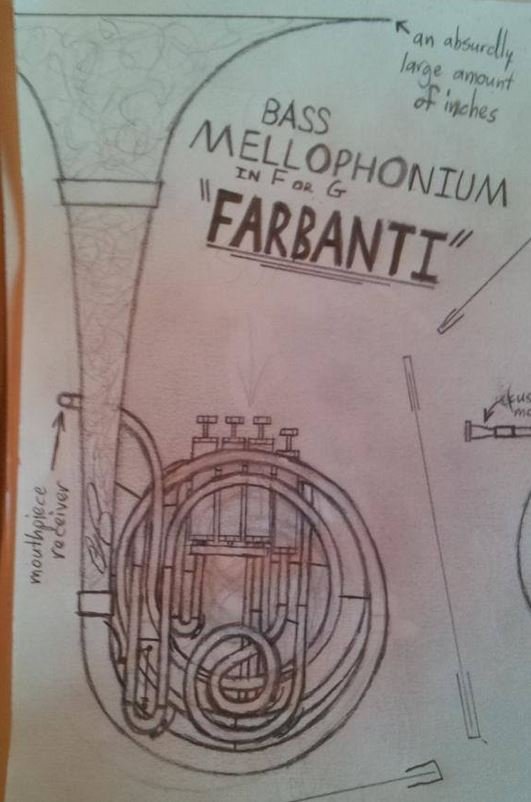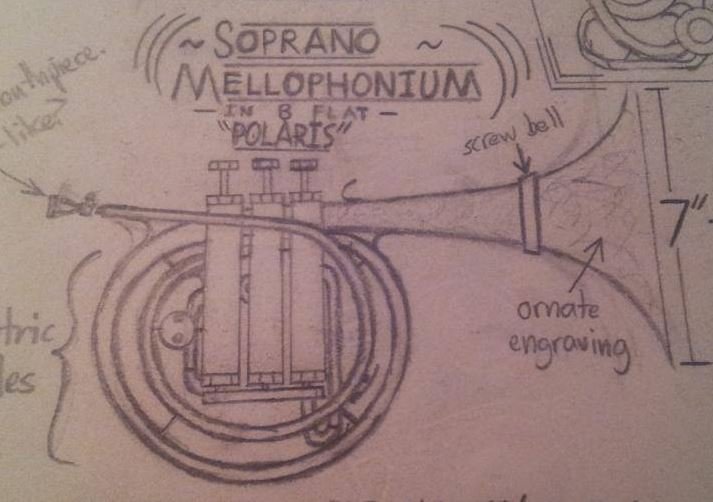Brass Instruments That Don't Exist (But Should)
It goes without saying (especially on this particular website) that there are a lot of brass instruments out there. Some probably shouldn’t exist, and others are probably not distinct enough to really deserve their own name. But they exist nonetheless, and going down the rabbit hole to discover and make sense of all of them is an endeavor that takes years.
But even though the concept of a mouthpiece attached to a metal cone has been tried hundreds or even thousands of ways, I believe we have not explored all that is possible in the brasswind medium. More to the point, I believe there are some brass instruments that should exist…but don’t. That’s what I’m going to discuss here, and hopefully inspire intrepid makers to make them a reality. (I can dream, ok?) Naturally, these are just my personal opinions, and if you have a different idea of a non-existent brass instrument that you wish was less non-existent, I’d love to hear about it.
Alto Euphonium
This might be the instrument I wish existed the most - a true F or E-flat alto tuba in the British euphonium style, with 3+1 compensating valves, a much larger bore and bell throat than an alto horn, and a small trombone mouthpiece shank. Technically, an alto euphonium does exist: the Yamaha YEH-901ST, which was made in a very limited (14 or 15) run in 1984-85 for Yamaha artists. It only had 3 valves, none of them have ever been for sale, and Yamaha no longer has the tooling to make any more. So although it technically does exist, practically speaking it might as well not. But this is the idea.
Yamaha YEH-901ST alto euphonium in E-flat (picture from Hidekazu Okayama’s website)
I plan to get an alto euphonium custom made for me from parts, as I really believe in its potential. Hopefully that project might inspire makers to give the concept a try. If my alto euphonium project is successful, I may then think about trying a soprano euphonium as well.
(Compensating) Euphonium in C
A similar (but less radical) instrument I’d like to see more of is a professional compensating euphonium in C. This did exist as the Besson BE765C, a special order instrument available until the company moved to Germany in 2006. That tooling is also likely long gone, and the picture below is the only evidence I have ever seen of the model. I can’t imagine more than a handful were ever made.
Besson BE765C-2 euphonium in C (left), Besson BE765-2 euphonium in B-flat (right). Picture from Hidekazu Okayama’s website.
C euphoniums do exist and are used in some parts of the world, but apart from the Besson above there are none that I know of that are British-style professional instruments. C tubas are a standard for orchestral tubists…I see no reason why a British-style compensating euphonium in C couldn’t also have merit, especially as a doubling instrument for tubists used to C fingerings.
6/4 American-Style Tenor Tuba
There have been some extra-large compensating euphoniums in the past, but what I’m proposing goes a step further. Massive 6/4 York-style C tubas are very much in vogue…why not try that same blueprint an octave up? Give it 4 front-action pistons with a 5th rotor and orchestral tuba players will flock to it as a doubling instrument even more than the C compensating euphonium mentioned above.
Bass Euphonium
I know what you’re thinking: “Isn’t a bass euphonium just an F tuba?” And I don’t blame you for thinking that, especially when small bell British F and Eb tubas that look and sound like big euphoniums exist. But my thought for an instrument called “bass euphonium” would be to take the dimensions of a modern compensating euphonium (.590” starting bore size) and use them to build an instrument in low G. The goal is an instrument somewhere in between a euphonium and bass tuba in sound. I will admit, this one isn’t that important to me, but I think it would be an interesting experiment. I have seen a few very small bass tubas for sale that have seemed like really good candidates to cut down into a bass euphonium. I’ve even seen a piston F tuba with a 12-inch bell!
Soprano Mellophone/Mellophonium
A custom Holton Bb soprano mellophonium, made from parts
A soprano mellophone in high B-flat is something I’ve wanted for a long time. A couple have been cobbled together from parts using trombone bells (see the above picture), but that’s not really the real deal. I’m talking new mandrels and tapers that match a modern mellophone, just a scaled down for an instrument a 4th higher. I would suggest still using a trumpet shank and the same bore size as an F mellophone, as you still want it to feel like a mellophone. Truthfully, I would love a soprano mellophonium with a .500” bore, the same as the Conn 16E mellophonium. But as no maker makes a bell-front mellophone that large anymore, you’d have to do that first and then make the high Bb version. Which…I would also welcome with open arms. I love my 16E, but that design leaves a ton of room for improvement by a modern maker.
Lower Mellophones
If the mellophone formula can be expanded upwards, why not downwards as well? I used to own a Conn 8E ballad horn from 1930, which is essentially a tenor mellophone in C or B-flat. But (to my knowledge) a modern bell-front tenor mellophone is not something that anyone has ever attempted. I even think a bass mellophone in F (an octave below the standard mellophone) would have a lot of potential.
I have been fascinated by the idea of a complete mellophone or mellophonium family for a long time, and even drew freehand sketches of what I would imagine some of the non-existent members could look like.
An old sketch of mine for a bass mellophonium in low F. I figured for an instrument of this length, an upright design was much more practical as a normal mellophonium is already an ergonomic challenge.
An old sketch of mine for a soprano mellophonium in high Bb.
I even sketched a little sopranino!
A Real Bass Horn
I’m not talking about the “bass horns” out there that are basically just rewrapped tubas. I’m talking about a proper double horn a 4th or 5th below a normal double horn, with a small bore proportionate to that of a normal horn, playable by a horn player or trombone/euphonium player, with a dedicated mouthpiece that’s a deep horn mouthpiece scaled up to around big alto horn (~19mm) or small trombone size. Much like modern descant horns usually use the same bells as double horns, the bass horn could use standard XL-throat double horn bells, like those from a Conn 8D or King Eroica.
Endangered Instruments
This category is for instruments that do exist, and you can even order them in some cases, but they are FAR too rare - often nearly impossible to find and/or prohibitively expensive. These are instruments that I would like to see someone step up and make more widely available. I think rare, odd instruments like these are the perfect specimens for Jinbao/Wessex/etc. to take on. They’ll be playable enough, but also affordable enough that many players can try them out, and maybe get a boutique maker to make them a better one if they like it enough. If you start with the ultra-expensive handmade custom horns, nobody will ever buy one and the market won’t materialize. But if you start cheap, it just might. Certainly, these instruments would make more sense and have more merit than some of the odd instruments Jinbao has chosen to clone.
Soprano flugelhorn (they are always in Eb, but I would love one in F as well)
Flugelhorn in C (with pistons and a 3rd slide trigger, just like a normal flugelhorn)
Martin-style jazz flugelhorn (the Miles Davis horn)
Alto flugelhorn (G, F, or Eb, a la the Couesnon)
Alto cornet (G, F, or Eb, a la the DEG model 1220)
Alto trumpet (G, F, or Eb)
Bass cornet (C or Bb)
Double trumpets (Bb/low F, Bb/high Eb, C/high F)
High F and G trumpets, especially with 4 valves
4-valve C and Bb trumpets
3-valve Bach-style piston bass trumpet in C (with main tuning trigger)
Contrabass trumpet (F or Eb)
British-style alto horn with 4 valves (most recent example: Kanstul ZAT-1540)
British-style 3+1 compensating baritone horn
Double bell alto horns, baritone horns, and tubas
British-style 3+2 non-compensating euphonium
Large bore (.500") soprano trombone (with valve and tuning-in-slide)
Large bore (.547”) alto trombone (with Bb valve, possibly tuning-in-slide)
Alto trombone in F
Alto valve trombone (F or Eb)
Large bore, bell-up trombonium (a la Conn 90G)
Bass trombonium (3 valves, in low F or Eb)
Sopranino trombone (F or Eb)
Tenor trombone in C
Tenor or bass trombone in Bb/F/ascending C
Double valve (Bb/F/Gb) tenor trombone (in .508”, .525”, and .547”)
Modern bass trombones in low G or F (hey pBone, please make a straight F bass. I’d love you forever)
G contrabass trombone (a la Jeff Reynolds)
Tuba-shaped F cimbasso (a la Kalison)
Tubas in G and D (G = shortened small F, D = shortened 4/4 rotary C)
Valved ophicleide (I would LOVE to try an F bass valved ophicleide in a brass quintet)
French ascending piston double horn (a la Selmer Thevet Ascendant)
Ascending double horns in general
Bass Vienna horn (F/C)
Other Pie-in-the-Sky Ideas (that I’m not actively hoping for, but would be fun)
Alto superbone
A superbone with 2 valves and a 4-position handslide, requiring you to use both in tandem constantly to play chromatically
New sizes of corno da tirarsi (slide horn), and corni da tirarsi with a valve or two
New sizes of Wagner tuba (alto in Eb, contrabass in C, high double in Eb/Bb, low double in F/C)
French ascending piston triple horn and double descant horn
Soprano trombones in G and C
Soprano valve trombone (in a shape and taper that distinguishes it from a trumpet)
3 and 4 valve trumpets (not alto trumpets, or soprano bugles) in G
Contrabass cornet in F or G
4-valve compensating flugelhorn
Tubas/euphs/baritones/tenor horns/cimbassos with echo bells (like an echo cornet)
A Bb contrabass trombone that doesn’t suck (the most unrealistic idea here)
Alto Cornet
The alto cornet in F or E-flat is a very rare bird. It seems that most true alto cornets are rotary instruments in E-flat, with piston instruments being the rarer type. However, there is a fairly easy and affordable way to get your hands on an alto cornet, at least in North America: the DEG/Dynasty model 1220.
Like much of DEG/Dynasty’s product line in the 1970s, the 1220 was made for DEG by Willson. Willson also sold an E-flat version of the instrument in their home market of Switzerland; I would love to know if it was marketed there as an alto cornet, and which model came first. Meanwhile, DEG marketed the 1220 in the States as a “marching alto/French horn”, presumably in an attempt to cash in on the still-volatile marching alto brass instrument space. In accordance with the marketing, DEG supplied the 1220 with both an alto horn mouthpiece and a French horn mouthpiece with adapter. Despite the marketing though, the 1220 is a true alto cornet in F (or E-flat, using the factory E-flat slide), and not a solo alto or any sort of mellophone.
Over the years I have seen quite a few come and go on eBay, and it seems that they were made with at least three different bell sizes. The one I owned had the smallest and most common size that I have seen, at about 6.1”. Most I’ve seen have been branded DEG, but I have also seen larger-belled models branded Dynasty. The 1220 evidently stuck around long enough to go through some changes, though how long exactly I don’t know. I also don’t know if the Dynasty-branded versions were given a different model number.
The five pictures below are the bell stamps on five different 1220s; the middle and far right are mine, while the three others are from around the Internet. I’ve ordered them in what I am guessing is the correct chronological order from left to right. All five instruments have “Made by Willson” stamped on the valve block.
The 1220 has a trumpet shank, accepts flugelhorn mutes, and is not much larger than a standard B-flat cornet. I found that alto horn mouthpieces worked the best for me, and out of my alto pieces I felt the Kelly 3W was the best fit. I’ve also had good results with an extremely small trombone mouthpiece.
DEG 1220 alto cornet (bottom) next to Bach CR-310 B-flat cornet (top)
The 1220 plays very well, and despite overwhelming external similarities to the 1970s Dynasty III alto bugle (also made by Willson), it sounds noticeably different even when both are played with the same mouthpiece. The Dynasty III sounds like a big flugelhorn (which is essentially what it is) with a horn-like edge when pushed, while the DEG 1220 is all cornet. It is noticeably brighter and easily colored, with a rocking low register and a secure high register that requires a good deal of effort above written high C (sounding F5). Unlike many uncommon alto brass instruments, the 1220 has lock-tight slots. Intonation is not perfect but easily manageable.
While I don’t believe the 1220 is much of a soloist’s instrument, it is a champion at playing in a brass section. It can blend seamlessly with trombones or flugelhorns, and I have used it very successfully in recording sessions to do just that. In a 6-part horn section consisting of 2 trumpets, flugelhorn, alto cornet, and 2 trombones, the alto cornet is the perfect middle voice. The Yamaha YMP-201 (non-M) circular mellophone has similar qualities, but the DEG 1220 is more convenient to bring to a session due to its very compact size and forward-facing bell. This also makes it an excellent desk instrument for the alto brass player, or even the low brass player. Finally, the 1220 is an excellent substitute for alto horn, as it sounds closest to that instrument.
In short, the DEG 1220 is an excellent instrument that any multi-brass player could find good uses for, especially in the studio. They don’t show up for sale very often, but they usually go for a few hundred dollars. They are usually listed as a mellophone, so you’ll have the most luck finding one with a search for mellophones.













